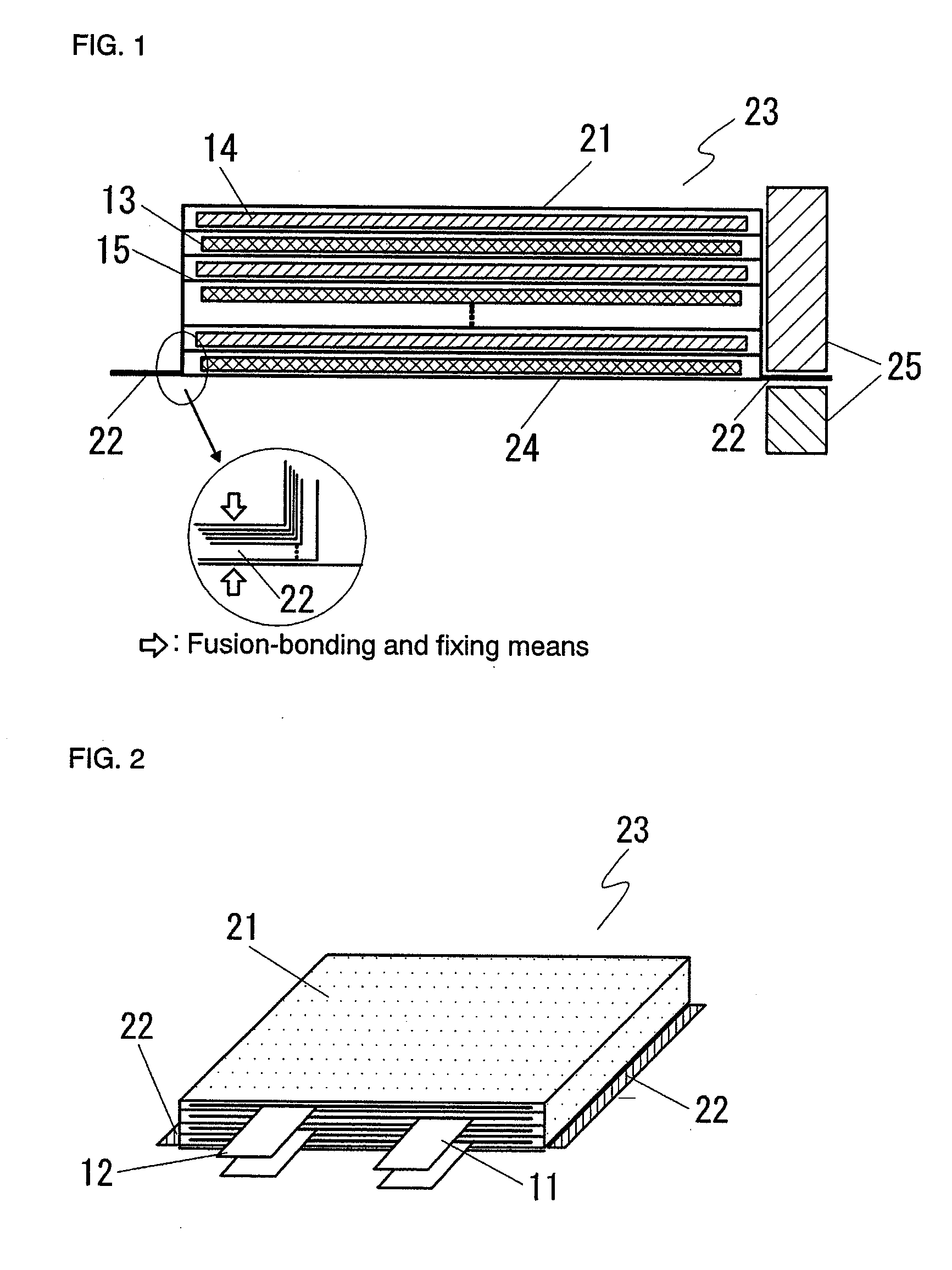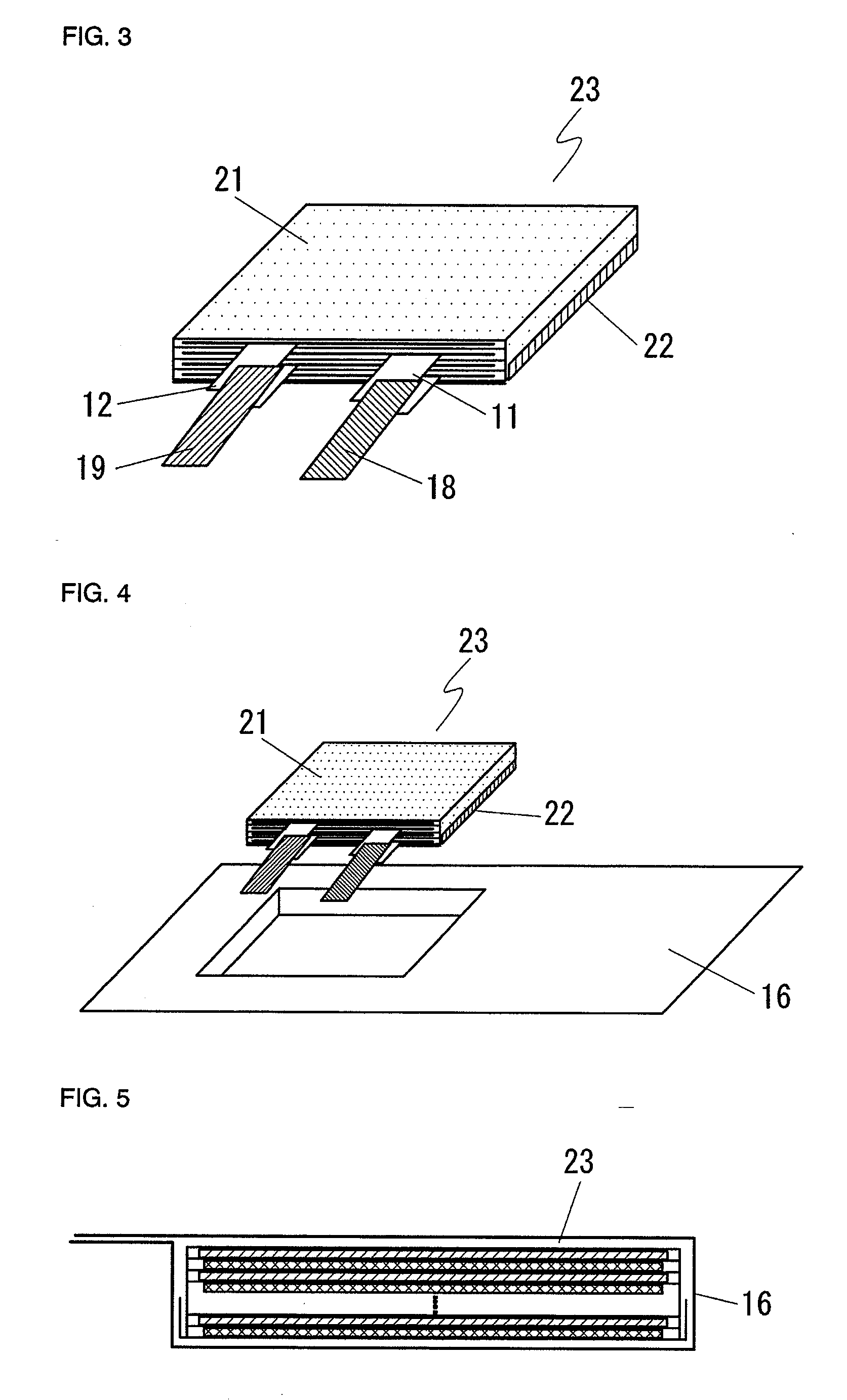Stack-type lithium-ion polymer battery
- Summary
- Abstract
- Description
- Claims
- Application Information
AI Technical Summary
Benefits of technology
Problems solved by technology
Method used
Image
Examples
example 1
[0048] Example 1 will be described with reference to FIGS. 1 to 5. FIG. 1 is a sectional view illustrating the state when insulating porous sheets enclosing the electrode stack are being fusion-bonded and fixed in Example 1 of the stack-type lithium-ion polymer battery of the present invention; FIG. 2 is an oblique perspective view illustrating the state after fusion-bonding and fixing the insulating porous sheets illustrated in FIG. 1; FIG. 3 is an oblique perspective view illustrating the state after bending the fusion-bonded portions of the insulating porous sheets illustrated in FIG. 2; FIG. 4 is an oblique perspective view illustrating the state when the electrode stack illustrated in FIG. 3 is being placed into the laminate package body; and FIG. 5 is a sectional view illustrating the state after packaged with the laminate material in Example 1 of the stack-type lithium-ion polymer battery of the present invention.
[0049] A cathode 13 was fabricated as follows. First, a mixtur...
example 2
[0061]FIG. 6 is a sectional view illustrating the state when insulating porous sheets enclosing the electrode stack are being fusion-bonded and fixed in Example 2 of the stack-type lithium-ion polymer battery of the present invention, and FIG. 7 is an oblique perspective view illustrating the state after fusion-bonding, fixing and bending the insulating porous sheets illustrated in FIG. 6.
[0062] The insulating porous sheet 24, which had been cut to 100 mm×170 mm so as to be larger than the coated area of the anode, was placed on a concave mold 26 set at a width of 75 mm so as to be larger than the anode width of 73 mm; the cathode 13, the separator 15, the anode 14 and additionally the separator 15 were sequentially stacked in this order so as to form 10 pairs of the cathodes and the anodes. In this case, the insulating porous sheet located on the uppermost surface corresponds to the insulating porous sheet 21 on the upper end surface of the electrode stack 23. Then, a portion, whi...
example 3
[0065]FIG. 8 is an oblique perspective view illustrating the state when the electrode stack is being placed into the laminate package body in Example 3 of the stack-type lithium-ion polymer battery of the present invention, and FIG. 9 is a sectional view illustrating the state after placing the electrode stack illustrated in FIG. 8 into the laminate package body.
[0066] In this Example, the electrode stack 23 was fabricated in the same manner as in Example 1, the electrode stack was sandwiched from above and below by non-embossed flat-plate-like laminate package bodies 17 as shown in FIG. 8, and the portion thereof other than the liquid injection portion was thermally fusion-bonded as shown in FIG. 9. Except the above, the stack-type lithium-ion polymer battery was obtained as described in Example 1.
PUM
| Property | Measurement | Unit |
|---|---|---|
| Thickness | aaaaa | aaaaa |
Abstract
Description
Claims
Application Information
 Login to View More
Login to View More - R&D
- Intellectual Property
- Life Sciences
- Materials
- Tech Scout
- Unparalleled Data Quality
- Higher Quality Content
- 60% Fewer Hallucinations
Browse by: Latest US Patents, China's latest patents, Technical Efficacy Thesaurus, Application Domain, Technology Topic, Popular Technical Reports.
© 2025 PatSnap. All rights reserved.Legal|Privacy policy|Modern Slavery Act Transparency Statement|Sitemap|About US| Contact US: help@patsnap.com



